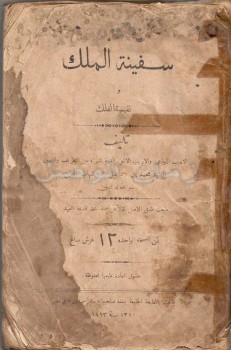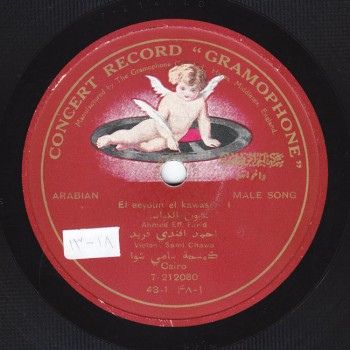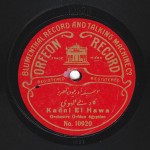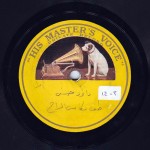The Arab Music Archiving and Research foundation (AMAR), in collaboration with the Sharjah Art Foundation (SAF), presents “Niẓāmunā al-Mūsīqī”.
Dear listeners,
Welcome to a new episode of “Niẓāmunā al-Mūsīqī”.
Today, we will be discussing the history and types of Music Notation with Professor, historian, artist and composer Mustafa Said.
All these titles?
And more…
Briefly, international music notation today includes the musical score: five lines and five spaces with the notes or symbols representing the music to be transcribed.
Before discussing this contemporary type… Were there other types of music notation, especially in ancient history?
There were many types: some with symbols and others with letters. Even today’s five-line staff is a very developed type of symbol notation.
Historically, what is the oldest indication on the existence of music notation?
I think that the Greek nation after Alexander the Macedonian is the first civilization that produced musical scores from which we can deduce a maqām system.
We can’t determine their precise duration or the segmentation of the lyrics on to the duration, but we can determine the melodic dimensions.
Did it have a specific form?
It is closest to today’s music notation in the tradition of the Orthodox Church, i.e the Byzantine tradition. Still, Byzantine notation is much more developed. But the bases are the same: the notation consists of ascending and descending (rising and falling) symbols placed above text syllables.
But unfortunately we do not have the apostrophe, or the lengthenings and shortenings existing today in Byzantine notation that indicate the duration of the note’s lengthening or the duration of the stop on the scale, or how to perform a rising or falling embellishment/ornamentation (trill)…etc. Even transcribing the notes above the lyrics in Byzantine notation is very developed.
Before that, it only included the word and the melody: the first or the second melody for example and the rising or falling melodic symbols.
Unfortunately, there are no indications about the rhythm or the note’s duration, i.e. 3/4 or 2/4…etc.
It only appeared in the 7th century with Charlemagne and Gregorian Chant, and later with the alphabetical notation of Ṣafīyyiddīn al-Urmawī.
So music notation existed in Arab music?
Yes. It was alphabetical. In the Umayyad era, it is said that Ya‘qūb al-Dimashqī noted some Byzantine melodies following the symbols used in Greece. Some trace the transcriptions/scores in their possession back to the 17th and the 16th centuries in Greece, adding that these melodies were transcribed by Ya‘qūb al-Dimashqī, the Minister of Finance during the era of ‘Abd al-Malik Ibn Marwān then lived in isolation in the Monastery of Mār Sābā in Jerusalem. He invented the Octoechos system still followed today in the notation of Antiochian Orthodox Church rhymes.
Later on, Al-Kindī –a non-musician– wrote in his book exercises for ‘ūd players that lack any type of precise dimension ratios and rhythm, as well as any determined score duration.
The types of notation include the one described in book “Al-Aghānī” as well as in the music transcription of Ibn al-Kātib and even Ibn al-Ṭaḥḥān…
For example, book “Al-Aghānī” includes the following: “sabbāba fī majra al-wusṭa”, “ḍarb bi-al-ḍabt”, or “qismat al-laḥn”..etc.
Thus one will surely know that:
the rhythm is either a slow 3/4 or a fast 4/4;
that sabbāba fī majra al-wusṭa is the equivalent of ourbayyātī;
that wusṭa fī majrāhā is the equivalent of our sīkāh ‘irāq;
or that wusṭa fī majra al-khunṣur is the equivalent of the sīkāh in Aleppo
..etc.
There are symbols that indicate the maqām and the rhythm, starting with Abū al-Faraj al-Aṣfahānī’s book “Al-Aghānī” up to Ibn al-Kātib.
But the correct notation that can be read and sung is Ṣafīyyiddīn al-Urmawī’s.
Did book “Al-Aghānī” indicate the maqām and the rhythm? Were they explained in other books of the same period? Or were they explained in book “Al-Aghānī”, such as the meaning of sabbāba fī majra al-wusṭa for example?
His book includes letters between Ibrāhīm al-Mahdī and Isḥāq al-Mawṣilī that help deduce the rhythmic system as well as the melodic system.
Also, Al-Ḥasan Ibn al-Kātib explained the wusṭa and that it included three types of dustān al-wusṭa: wusṭa al-furs, wusṭa al-‘arab, and wusṭa zalzal.
When he states that there is half a dimension in wusṭa al-furs and that wusṭa al-‘arab goes farther, we can deduce that wusṭa al-‘arab is more than a semitone, i.e. between 2/3 and 3/4 of a tone. Thus, sabbāba fī majra al-wusṭa –considering the wusṭa al-‘arab as the default wusṭa– is the bayyātī maqām.
The notation of the rhythms, to my knowledge, including…
Al-thaqīl al-awwal and al-thaqīl al-thānī, al-khafīf al-awwal and al-khafīf al-thānī, as well as the ramal, which he explained with the ‘arūḍ. For example: “fā‘ilātun fā‘ilātun”, a 3-pulse’ rhythm that is the equivalent to the baḥr ramal kāmilin the ‘arūḍ.
He also wrote that the rajaz includes iss thus producing the 4/4 thaqīl awwal, that the rajaz sarī‘will produce a khafīf like the fast 6/8 rhythm, all this according to his ‘arūḍ calculations. The dum and the tak are not easily deduced with precision, but at least, one can very easily deduce the beats, i.e. 6/4, 6/8, 2/4, or 3/4 from book “Al-Aghānī”.
… This only appeared in Al-Urmawī’s notation.
Iraqi analyst Zakariyyā Yūsuf studied Ibn Zayla’s book “Al-Kāfī fī al-Mūsīqa”, and attempted to illustrate the rhythm with ten symbols, since the original transcription included neither dum nor tak.
He explained each rhythm through deduction: assuming there was a dum in the beginning, the middle, or the end, and tak that he distributed in a way or in another. He used these examples to illustrate the old Abbasid rhythm.
True. Many of the surviving books –such as Al-Kindī’s, Al-Fārābī’s, Ibn Sīnā’s, or Al-Munajjim’s book that can’t be about music– were not written by musicians, but by polymaths, such as Al-Kindī.
Al-Fārābī wrote a complete work on the system, explaining the wusṭa, the sabbāba, the bunṣar, and the khunṣar dimensions according to the Pythagorean ratios. God knows to what extent this reflects the practice system.
Even today in the 21st century, the relation between theory books and reality is questionable, even though we have discs, recordings.. etc.
There was none of that in previous centuries. Then, philosophers wrote about music…
So, the only practice books are:
the letters mentioned by Abū al-Faraj al-Aṣfahānī in his book, whose content was probably altered over and over by those who copied them;
Ibn al-Kātib’s book with the information about Isḥāq al-Mawṣilī;
the book by Ibn al-Ṭaḥḥān who seems experienced in music. Still, God knows what changes were brought by those who copied it, what they erased and what they added. The manuscript we have is from the 19th century, and we do not have any in his hand.
Is there a relation between music notation during the old Abbasid era and the Greek music notation? Was it an extension? Or did it consist of different attempts with different patterns and explanations?
Like all theory books, “Al-Mūsīqī al-Kabīr” translates Aristoxenus, Boethius, and Pythagoras. Then invalidated them and talked about what was done in Arab music, and mentioned new ratios to the dimensions he implied.
He wrote nothing on notation. Either it had not reached him yet or he simply did not understand it. For example, Abū al-Faraj al-Aṣfahānī‘s book “Al-Aghānī” mentions the ukhṭāsiyya, saying thatAl-Yazīd gathered Persian and Arab musicians, as well as those who practiced the ukhṭāsiyya, i.e. the Octoechos probably. It seems he had understood Octoechos as ukhṭāsiyya.
Many researchers focused on Ṣafīyyiddīn al-Urmawī and his books, notably those including the maqām system as well as music notation, exercises, and nomenclature. How precise and easy is Ṣafīyyiddīn al-Urmawī’s notation? How much does it help us understand the music transcriptions in these books?
Luckily, we have several copies of Ṣafīyyiddīn al-Urmawī’s books “Al-Adwār”, and “Al-Risāla al-Sharafiyya” in which he repeated what he had written in “Al-Adwār” added to new information.
The books written by those who came after Ṣafīyyiddīn al-Urmawī such Quṭb al-Dīn al-Shīrāzī, ‘Abd al-Qādir al-Marāghī, and Dimitrie Cantemirwill further explain his transcription system. The analysis of Ṣafīyyiddīn al-Urmawī’s music transcriptions conducted by Prof. Nidaa’ Abu Mrad did in fact uncover a lot: only by segmenting the melodies following the ‘arūḍ, the melody will correspond exactly to what he wrote.
His musical system written down in “Al-Mujannab” and the maqām names that are linked to the maqām namesused today, coupled with an in-depth reading of the books that followed, helps us understand his maqām system without any confusion. The same goes for the rhythm including the dum and the tak.
As for the instrumental types, he segmented the musical scale into 18 notes: A; B; J; D, H; W; Z; Ḥ; Ṭ; Yā; Yab; Yaj; Yū; Yaz; Yaḥ; Yaṭ..etc. followed by Yakā; Yakab; Yakaj on the second dīwān.
The deduction is very easily reached. There are 18 dimensions and he wrote the distance between them. One can easily deduce the ascending and descending (rising/falling) tendency –even the comas indicate the exact note to play–. Also, he wrote the ratios according to the string picking/playing on the ‘ūd. For example: A6 implies playing the note A 6 times. The iss he wrote only concern the silences in the duration.
Reading Ṣafīyyiddīn al-Urmawī’s scores is easy and leads to no confusion. And thus, reading Quṭb al-Dīn al-Shīrāzī’s, Al-Marāghī’s, and Dimitrie Cantemir’s books is also easy.
So, the score went on after Al-Urmawī’s death?
Yes. Dimitrie Cantemiris the last who developed Al-Urmawī’s system in the late 17th century or in the 18th century –he died around 1701. He is the last one who noted following the alphabetical system. Before him, the alphabetical system invented by Ṣafīyyiddīn al-Urmawī was widely used in Persia and Turkey.
I noticed that each of the researchers, especially those who worked on explaining Al-Urmawī’s books and music scores in the 70’s and 80’s, explained the rhythms and the maqām based on his personal local influence, i.e the Iraqi researcher includes the lāmī and the Iraqi rhythms he extracted from Al-Urmawī; The Egyptian researcher tells about the rhythms and the maqām known in Egypt and that he extracted from Al-Urmawī’s book, etc.
Was it precise enough, or did it leave room for imagination?
The in-depth reading of the books written after Al-Urmawī does not lead to any confusion as to deducing the maqām or the rhythm, i.e. the dimensions and the rhythmic beats.
During a conference in Germany, I met with some Turks researching Dimitrie Cantemir’s melodies and subsequently Al-Urmawī’s melodies.
I sang to them Al-Urmawī’s “ ‘Ala ṣabbikum” and they sang it in the same manner. The only difference consisted in the ornamentations/embellishments we added, as he had written none. Oriental musicians can’t sing a tune without ornamenting it: a melody devoid of ornamentations is not considered Arabic. i.e.: It is impossible to sing “ ‘Ala ṣabbikum yā ḥākimīna taraffaqū” (♩) in this manner.
I added ornamentations, and so did they. But the result is the same… And we had never met before.
So, an in-depth reading of the books written after Al-Urmawī, i.e. those by Quṭb al-Dīn al-Shīrāzī, Al-Marāghī, and up to Dimitrie Cantemir, does not lead to any confusion as to Al-Urmawī’s scores or the scores transcribed by those after him.
Could you play for us “ ‘Ala ṣabbikum”?
Of course. We will also listen to the manner followed before him. He wrote a nawrūz section followed by the melody “ ‘Ala ṣabbikum yā ḥākimīna taraffaqū”.
What do you mean by the nawrūz “section”?
He may have implied a dūlāb or an introduction, or even the section he composed to the mustaqīm i.e. the rāst. He wrote that the ‘ūd could play a phrase, so he transcribed it. It also seems that this “section” can be an equivalent of the contemporary taḥmīla.
Or a musical piece.
A very short musical piece.
He wrote that this phrase should be played on the ‘ūd, and it seems that he implied that it should be played solo (in the contemporary appellation). He said that the instruments alternate. The “section” seems to imply any musical piece, and it seems there are many “sections”: an introduction, a taḥmīla…etc.
Later on, the bashraf (peshrev or peshrū)appeared with Quṭb al-Dīn al-Shīrāzī. But we found no transcriptions of those, while we did find some by ‘Abd al-Qādir al-Marāghī, and many by Dimitrie Cantemir.
Kuwaiti researcher Yūsuf al-Dawkhī translated “ ‘Ala ṣabbikum” with a 6 or 3-pulse’ ṣawt ‘arabī melody… “ ‘Ala ṣibkum yā ‘ādhilīn taraffaqū… taraffaqū” (♩)
The dārij can be translated as an Arabic rhythm, but the interpretation will only happen with the performance. The initial written melody does not lead to any confusion: one is free to perform it slowly or fast, to perform a part and improvise a little… But the melody and the rhythm segmentation remain.
(♩)
‘Ala ṣabbikum yā ḥākimīna taraffaqū Wa-min waṣlikum dawman ‘alayhi taṣaddaqū
Wa-lā tutlifūhu bi-al-ṣudūdi fa-innahu Yuḥādhiru an yashkū ilaykum wa-yushfiqu
This is the segmentation exactly as he wrote it. Yet one can decide how to perform it, whether fast or slowly, whether to stop in the middle and improvise, whether to perform it as a ṣawt or as a dawr… it is a matter of choice.
Could you play for us a sample of this melody? And then the same sample with different ornamentations in a different interpretation/performance, i.e. with more freedom, in order for us to offer two examples or two possible explanations of the same transcribed melody.
Of course Mr. Aḥmad.
This will provide an opportunity to compare, even for me…
(♩)
Of course, after Ṣafīyyiddīn al-Urmawī, musicians went on transcribing music, and as I mentioned, followed the system he invented. Did they develop it? Was more of the period’s music transcribed?
Baghdadi Ṣafīyyiddīn ‘Abd al-Mu’min al-Urmawī lived in the 13th century. He died in 1294. He was the last clerk of the Dār al-Ḥikma library in Baghdad during Caliph Al-Mustanṣir’s era. Then he served at the court of the Sharafiyya nation after Baghdad was invaded and Hulagu died.
Those who continued his journey include Quṭb al-Dīn al-Shīrāzī who lived in Iran and who apparently transcribed pieces in Persian as well as in Arabic.
One of his melodies is much longer than those transcribed by Ṣafīyyiddīn al-Urmawī such as “Yā malīkan bihi yaṭību zamānī” whose composition Quṭb al-Dīn al-Shīrāzī attributed to Ṣafīyyiddīn al-Urmawī. He wrote the tarannum and the instrumental lāzima in the middle of the melody. It is more evolved that the melodies transcribed by Ṣafīyyiddīn al-Urmawī, even though he attributed it to Ṣafīyyiddīn al-Urmawī. So it seems that Ṣafīyyiddīn was not capable, or had not developed his manner to the point of being able to note such as this great melody, because Quṭb al-Dīn al-Shīrāzī’s silences and the manner of segmenting the ‘arūḍ onto the poetry is much more precise than Ṣafīyyiddīn al-Armawī’s, as it allows more ornamentation and a more detailed musical notation. More precise does not imply that the other one includes interpretation, as both do not. But Quṭb al-Dīn al-Shīrāzī’s transcription of the details and ornamentations helps us find out how they ornamented a tune, because he even transcribed the tarannum “tarā tarā dīrtā”…etc. that is like “Yā lēl yā ‘ēn” or “amān”…etc. as well as many details in the melodies. After him, there was of course ‘Abd al-Qādir al-Marāghī.
Are all Al-Shirāzī’s music scores limited to transcriptions of songs? Or did they transcribe different musical pieces or different singing forms?
Al-Shirāzī transcribed Ṣafīyyiddīn al-Urmawī’s qawl, which he calls ṣawt, and the basīṭ included in the ṣawt. He transcribed the basīṭ but not the nashīd (hymn). He said that the ṣawt includes the basīṭ and the nashīd, but he transcribed the basīṭ and not the nashīd. Whereas Quṭb al-Dīn al-Shīrāzī transcribed qawl and wrote about instrumental pieces.
What are qawl?
Qawl is a form resembling the muwashshaḥ, but it is more developed that the latter as to its melodic structure: it includes a first melody and a second melody, that are repeated before entering the third melody with a tarannum, followed by the conclusion to the second melody. But the instrumental intervals in the middle are more precise than those of muwashshaḥ.
 Do you think that the music and singing transcribed by Al-Shirāzī –since Al-Urmawī noted very little– and those after him, bear any relation to something that remained in Arab, Turkish or Persian music?
Do you think that the music and singing transcribed by Al-Shirāzī –since Al-Urmawī noted very little– and those after him, bear any relation to something that remained in Arab, Turkish or Persian music?
It does in Persian and Turkish music. Some elements from Dimitrie Cantemir’s and Al-Marāghī’s period either continued or were revived and were used later, because their reading is easy.
Concerning Arab music, musicians such as Al-Lādhiqī, Al-Ṣīḍāwī and Al-Ṣafadī in the 15th and in the 16th centuries transcribed in a totally different manner: they wrote the name of the note; the number of melodies was much smaller; and all were instrumental and initially included no singing.
Later, Muḥammad Shahāb al-Dīn wrote in “Safīnat al-Mulk wa-Nafīsat al-Fulk” about muwashshaḥ “El-‘uyūn el-kawāsir sabūnī” and called it “ ‘Uqdat Al-Ṣīḍāwī” (Al-Ṣīḍāwī’s knot). Aḥmad Farīd recorded at the beginning of the 20th century with Gramophone following his manner: with the same melodic pattern he defined in “Safīnat al-Mulk wa-Nafīsat al-Fulk”. I am almost certain that Aḥmad Farīd never read “Safīnat al-Mulk wa-Nafīsat al-Fulk”, but that he learned it orally.
Inherited it…
(♩)
Before discussing the 19th and the 20th centuries in detail and music notation during this period…
Those who came after Ṣafīyyiddīn al-Urmawī and transcribed music following his alphabetical system include Al-Shirāzī and Al-Marāghī in the 14th and the 15th centuries. Some transcriptions are wrongly attributed to Al-Shirāzī. Those who copied them wrote and altered.
We do not have a true estimate of the number of melodies transcribed by Al-Shirāzī or Al-Marāghī. The Turks we met in Germany told me that they are still discovering scores written in the hand of Kantāmīr in museums in France and in the United Kingdom.
We do not have the exact number of the works transcribed by the “Al-Jamā‘a al-Niẓāmiyyīn”, i.e. Ṣafīyyiddīn al-Urmawī and his pupils, or even those who transcribed alphabetically including Al-Ṣīḍāwī, Al-Ṣafadī, Al-Lādhiqī, and the author of “Shajar Dhāt al-Akmām” up to Mikhā’īl Mashāqa. But the notations produced by the 15th and 16th centuries musicians, except for Mikhā’īl Mashāqa, who are the “Shajar Dhāt al-Akmām”, i.e. Al-Lādhiqī, Al-Ṣafadī and Al-Ṣīḍāwī…etc. are very intricate. They wrote to the rāst dūkāh, sīkāh…etc. system, adding the lengthenings and the shortenings. One can thus deduce the duration of these melodies they described for the maqām.
Yet, we do not know exactly because new elements are still being discovered.
Can you play for us an example of the scores or the songs transcribed in Al-Shirāzī’s book?
Of course, with pleasure.
Let us listen to “Yā malīkan bihi yaṭibu zamānī” whose composing Quṭb al-Dīn al-Shīrāzī attributed toṢafīyyiddīn al-Urmawī.
Qawl“Yā malīkan bihi yaṭibu zamānī”, composed by Ṣafiyyiddīn al-Urmawī –according to Quṭb al-Dīn al-Shīrāzī– to the shadd muḥayyar ḥusaynī. I think that shadd means maqām. It seems that the maqām was called shadd at the time.
So, here is “Yā malīkan bihi yaṭibu zamānī” to the shadd muḥayyar ḥusaynī.
(♩)
“Niẓāmunā al-Mūsīqī” is brought to you by Mustafa Said.
- 221 – Zakariyya Ahmed – 12 (1/9/2022)
- 220 – Zakariyya Ahmed – 11 (1/9/2022)
- 219 – Zakariyya Ahmed – 10 (11/25/2021)
- 218 – Zakariyya Ahmed – 9 (10/26/2021)
- 217 – Zakariyya Ahmed – 8 (9/24/2021)
- 216 – Zakariyya Ahmed – 7 (9/4/2021)
- 215 – Zakariyya Ahmed – 6 (8/28/2021)
- 214 – Zakariyya Ahmed – 5 (8/6/2021)
- 213 – Zakariyya Ahmed – 4 (6/26/2021)
- 212 – Zakariyya Ahmed – 3 (5/27/2021)
- 211 – Zakariyya Ahmed – 2 (5/1/2021)
- 210 – Zakariyya Ahmed – 1 (4/28/2021)
- 209 – W-al-Lāhi lā astaṭī‘u ṣaddak 2 (4/6/2017)
- 208 – W-al-Lāhi lā astaṭī‘u ṣaddak 1 (3/30/2017)
- 207 – Bashraf qarah baṭāq 7 (3/23/2017)



